The average U.S. commercial building is approximately 53 years old – including thousands of assisted living facilities – and many of the aging pipes in these facilities are in need of rehabilitation. Traditional total pipe replacement involves removing all old pipes and replacing them with new. This requires contractors to cut and remove drywall, flooring Read more
Industry Blogs
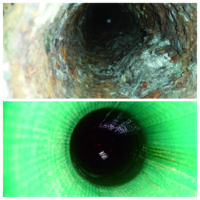
The average U.S. commercial building is approximately 53 years old – including thousands of assisted living facilities – and many of the aging pipes in these facilities are in need of rehabilitation. Traditional total pipe replacement involves removing all old pipes and replacing them with new. This requires contractors to cut and remove drywall, flooring, fixtures and finishes to reach plumbing systems. Residents are unable to live in their dwellings during this destructive phase and must be placed in temporary housing for several days while demolition occurs, and water is turned off.
Given the physical and mental health challenges many assisted living seniors face, forcing them into unfamiliar and ill-equipped temporary housing can be extraordinarily disturbing for residents, potentially expose them to asbestos and incur dramatic costs. Yet that is what occurs when a senior living community undergoes a total pipe replacement to repair leaking pipe systems.
Today’s modern In-Wall Pipe Rehabilitation process offers senior living communities reliable repair of vertical and horizontal piping systems without disrupting residents’ lives or incurring relocation expenses. This non-invasive form of pipe repair is ideal for pipes up to 12” in diameter and allows residents to remain in their familiar surroundings during the repair process.
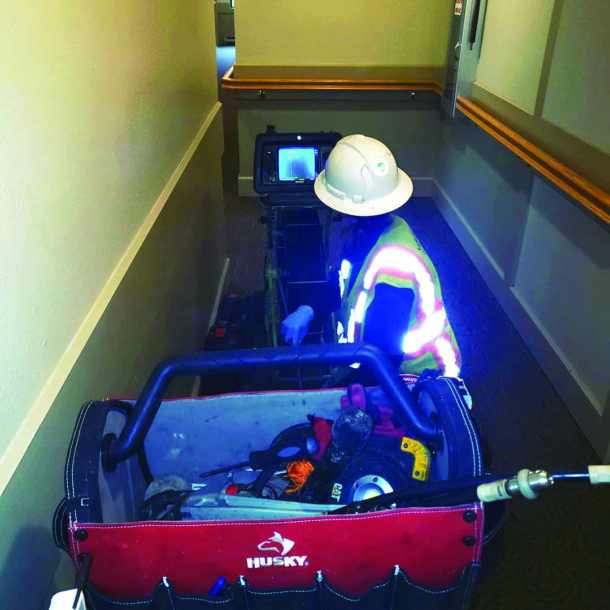
In-Wall CIPP Rehabilitation eliminates excavation and resident relocation, making it a minimally disruptive cost-effective alternative to total pipe replacement.
This field-proven technique has restored old and new high-rise commercial and multi-tenant residential properties’ plumbing systems faster and more cost effectively with less environmental impact compared to total pipe replacement for more than two decades. It’s effective for mains, stacks, vents and branch lines, which encompasses kitchens, tubs and toilets.
Preparation for In-Wall Pipe Rehabilitation begins with gaining access to each stack from the top floor. A basement bypass system is installed and removed each day, which allows residents to remain in their units while the project progresses. The stacks are then descaled and cleaned. CIPP liner is installed from the top floor to the basement bypass system. Once the liner cures, each branch line is reinstated robotically from the top floor access point. Completing one stack each week minimizes disruption and ensures residents have access to their bathrooms and kitchens each night.
Once vertical stacks are restored, horizontal pipes are addressed by reinstalling the basement bypass system to allow pipes under the building’s concrete slab to be descaled, cleaned and lined while each floor remains operational. CIPP Liner is then installed from each stack, moving toward the main sewer line outside the building. When the liner’s cure is complete, each branch line is reinstated robotically.
A comparison of a total pipe replacement and non-invasive In-Wall Pipe Rehabilitation project immediately demonstrates the advantages of the in-wall pipe rehab process. A retirement community in Washington State consisting of three multi-story buildings underwent a total pipe replacement. The cost to relocate the community’s residents during the pipe replacement totaled over $1 million alone. In contrast, another Washington State retirement community that employed the in-wall pipe rehabilitation process using Vortex’s Quad-Cure® 100% Solids Epoxy Resin and Liner didn’t require residents to leave their units, saving the exorbitant relocation, demolition and reconstruction expenses. Additionally, the in-wall pipe repair project was completed in roughly half the time of a total pipe replacement.
Depending on pipe diameters and conditions, there are several non-invasive in-wall pipe repair options that are significantly less expensive than traditional total replacement. A broad range of Quad-Cure Epoxy Resins and Liners are used in In-Wall Pipe Rehabilitation systems. Whether the repair involves main lines, laterals, branch lines, verticals, sectional repairs, cold weather or environmentally-sensitive areas, these materials stop leaks, improve flow and restore structural integrity. Brush-in-Place-Pipe (BIPP) uses 100% solids epoxy lining material to reline pipes as small as 1 ¼-inch diameter and corroded cast iron pipes. CIPP utilizes epoxy resins to restore structural integrity to cracked or physically compromised larger diameter pipes. UV CIPP, a superior cost-comparable alternative to vinyl esters, employs methacrylate resins that fully adhere to vertical plastic and clay pipes, such as stack and vent pipes, for an impregnable bond.
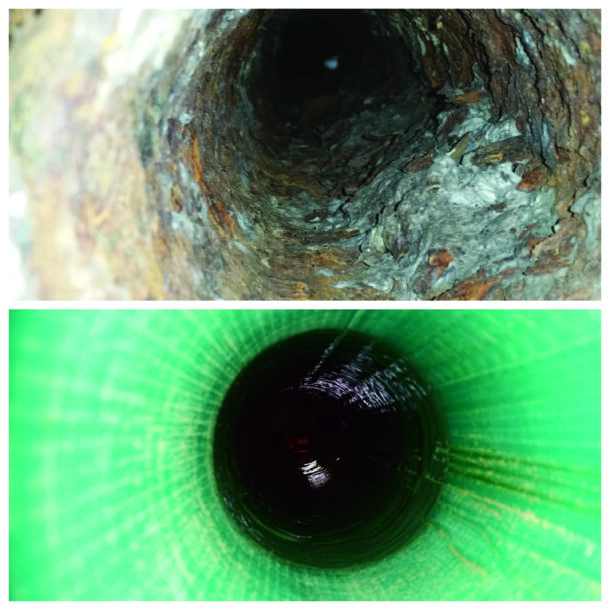
In-Wall Pipe Rehabilitation provides reliable, durable pipe repair communities and residents can depend upon. Shown: Vortex Companies’ Quad-Cure Epoxy Resin and Liner.
It’s common for a variety of materials to be required for a trenchless plumbing and sewer pipe rehabilitation project. Sourcing materials from multiple vendors can take time, extending a project’s duration and cost. Vortex’s ability to be a single source for all needed materials – including customized materials – expedited the completion of an Oregon retirement community’s In-Wall Pipe Rehabilitation. With 10 floors, 18 stacks and more than 2500 linear feet of deteriorating cast iron pipes, In-Wall Pipe Rehabilitation was an ideal choice for the project to avoid disrupting and relocating the community’s 150 elderly residents. This project required multiple materials, which Vortex provided to eliminate sourcing delays and enable the expansive undertaking to be completed in just five months while residents remained in their units.
Traditional total pipe replacement requires more manpower, time and materials than modern CIPP and pipe relining methods. It also incurs more costs as excavation damage to drywall, flooring and more must be repaired forcing resident relocation due to the inability to access water.
In-Wall Pipe Rehabilitation maintains residents’ quality of life while providing durable, reliable pipe repair. As the in-wall pipe systems in high-rise and multi-story buildings age, this modern trenchless pipe repair approach represents an optimal, cost-effective option that benefits tenants and building managers alike.
Caption: Quad-Cure® Epoxy Resin creates a structurally sound pipe within a pipe during non-invasive In-Wall Pipe Rehabilitation projects.
In-Wall Pipe Rehabilitation provides reliable, durable pipe repair communities and residents can depend upon. Shown: Vortex Companies’ Quad-Cure Epoxy Resin and Liner.
In-Wall CIPP Rehabilitation eliminates excavation and resident relocation, making it a minimally disruptive cost-effective alternative to total pipe replacement.
Author: Andrew Gonnella is President, Products Division for Vortex Companies. In this role, he oversees the development and expansion of Vortex’s existing product line, identifies new products and develops new distribution channels. He holds a Bachelor of Arts degree from University of Maryland College Park and a Master of Business Administration from University of Maryland Robert H. Smith School of Business.
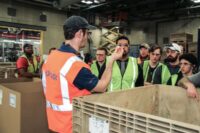
If you’re like many other business owners in the trades, you know that recruiting is a constant challenge. In fact, for some businesses, recruiting and keeping talent is the top issue in the company! Finding people to maintain your company’s current size or to grow is vital; after all, even if your company is overwhelmed Read more
If you’re like many other business owners in the trades, you know that recruiting is a constant challenge. In fact, for some businesses, recruiting and keeping talent is the top issue in the company! Finding people to maintain your company’s current size or to grow is vital; after all, even if your company is overwhelmed with calls, you can only do the amount of work you have employees for.
When will this situation end? I have bad news for you: it won’t. As older technicians age out and retire, they’re not being replaced by younger technicians as quickly as they’re needed. The only road to salvation is acknowledging that society will not fix your problem. YOU are going to have to save yourself!
Here’s the good news, however: you can train your own employees and solve your recruiting woes. And it’s not as hard as it sounds. Plenty of businesses are training their own workforce and finding great success!
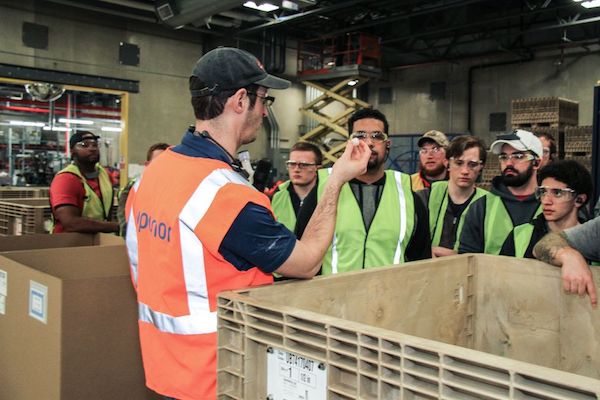
Why attempt an in-house training program?
The benefits of creating your own technicians far outweigh any challenges that an in-house training program might foster. Training someone from the ground up eliminates bad habits that most experienced new hires carry in the door. Homegrown techs are prepared to do things the way you want them done. Best of all, there’s no shortage of training options for any trade. Online and virtual reality training curricula have come a long way.
Refine your search
Years ago, a hiring manager could list specific skills, traits, or abilities they were looking for in candidates and then choose from a variety of applicants. While that was once an effective staffing strategy, it doesn’t necessarily work in these challenging recruiting times.
Hiring today is about attitude, behavior, character, and work ethic. Think about this: you can probably teach anyone technical skills, but attitude? Character? These characteristics are more challenging to instill. Removing the technical aspect from a candidate search then leaves you open to individuals who have great character and simply need to be taught technical skills.
Opportunities everywhere
If you’re looking to fill your training rolls, you should always be recruiting, and there should be opportunities everywhere. If you went about your day with the keywords “attitude, behavior, character, and work ethic,” how many individuals might you encounter who embody some or all of those words? You might be surprised. Think about a service desk clerk you saw dealing with a difficult situation. Consider the hustle of the barista at your coffee shop or the stocker at your local grocery store. You can spot talent when you see it. What if those people could be your next great technicians? They could be!

Build relationships with local youth
The service and replacement industry is about building and maintaining relationships with customers. Why not apply the same principles to creating and maintaining your talent pipeline? What relationships do you have with your local high schools? Have you participated in any recent career days? How about offering to be a guest speaker?
If your local high school doesn’t have any shop classes, it doesn’t matter! STEM (Science, Technology, Engineering, Math) has seen an enormous push in nearly every level of public instruction in the last decade. The plumbing, HVAC, and electrical trades are involved in all aspects of STEM. Imagine a discussion that explains scientific principles the kids are learning about in class and a demonstration of real-world applications inside the trades. Talk about a fertile ground to grow your workforce!
Clubs and organizations are significant pipelines for talent as well. Think about the 4H or FFA chapters near you, or Scouts troops.
Now, you might be saying, “But I need someone now, not kids!”
Let me ask you this: Where would you be now if you had started doing all this five years ago? Kids grow up and graduate, and not all of them are going to want to enter a four-year college. Some of them might be a great fit for your company’s training program; some of those kids might become some of the best technicians you have.
Consider veterans and career jumpers
Veterans moving from active duty to reserve status, or those discharged into civilian life can be good candidates to fuel your company’s growth. Another group of people to look at are career jumpers. Career jumping is when those already established in a career decide they want something else and move in a different direction. You already know what the trades can offer – great pay, great work environment, and a great career. Your company might be exactly what someone who wants to change careers is looking for!
When you open in-house technical training to a wider pool of potential candidates, you help yourself solve the challenge of today’s recruiting environment. The time to start is today. You’ll never know the vast opportunities surrounding you if you don’t start taking action.
 Guest Blogger: Jeff Atwell started in the plumbing trade the first business day after his high school graduation. He has more than 30 years of experience with residential and commercial service, as well as with residential new construction, and discovered a passion for teaching as an instructor at his local apprenticeship school. Jeff was the first technical coach hired to work on Nexstar Network’s NexTech Academy program. Since then, he has been working to create the best program focused on residential plumbing service. He can be reached at jeffa@nexstarnetwork.com.
Guest Blogger: Jeff Atwell started in the plumbing trade the first business day after his high school graduation. He has more than 30 years of experience with residential and commercial service, as well as with residential new construction, and discovered a passion for teaching as an instructor at his local apprenticeship school. Jeff was the first technical coach hired to work on Nexstar Network’s NexTech Academy program. Since then, he has been working to create the best program focused on residential plumbing service. He can be reached at jeffa@nexstarnetwork.com.

Valves play an essential role in plumbing systems. They control water flow by limiting or stopping the flow based on placement. But one quick trip down the plumbing aisle, and you’ll quickly find that PVC valves come in various styles. Knowing what valve is needed for which purpose takes some skill. As a general rule Read more
Valves play an essential role in plumbing systems. They control water flow by limiting or stopping the flow based on placement. But one quick trip down the plumbing aisle, and you’ll quickly find that PVC valves come in various styles. Knowing what valve is needed for which purpose takes some skill.
As a general rule, if you’re looking for a non-corrosive plumbing option or you have specific needs to meet hygiene standards or green building goals, PVC valves check all the right boxes. While they are technically made from a plastic polymer, these valves have become a preferred option over most metal alternatives.
What is a PVC Valve?
Traditionally, plumbing valves are made from different types of metals. Brass, cast iron, bronze, stainless steel, alloys, galvanized metals, and others serve different purposes. For example, salt water is highly corrosive and requires stainless steel or PVC fittings as other metals will easily rust.
PVC, or polyvinyl chloride, is not a metal. It’s a synthetic plastic polymer that provides a highly durable and cost-effective option for plumbing fixtures. PVC has been around the plumbing world a little longer than you may have realized. Pipes made from this polymer were first introduced in 1932. By the 1970s, pipes and valves made from PVC had found their way to mainstream use.
These valves are some of the most versatile, fitting appropriate uses across many applications. PVC valves can be utilized for:
- Domestic Irrigation: PVC is the top choice for providing water for landscaping maintenance.
- Water Treatment: PVC is a chemical-resistant, non-corrosive material ideally suited for water treatment facilities.
- Water Features and Wellsprings: The same properties that make PVC a smart choice for irrigation systems also make it a natural choice for garden water features.
- Aquariums: PVC is one of the few materials aside from stainless steel that can resist the corrosion of salt water, making it a good choice for aquariums.
- Landfills: Any plumbing systems in landfills need to tolerate various chemicals, making chemical-resistant PVC a natural choice.
- Swimming Pools: This same chemical-resistant property makes PVC the best choice for chlorinated swimming pools.
- Chemicals: PVC is the best choice for a wide variety of corrosive chemicals.
- Food: The same properties that make PVC environmentally friendly also lend themselves well to food safety. PVC valves are a common choice in residential and commercial kitchens.
- Healthcare: More than 10 million quality-control tests prove that PVC plumbing fixtures are sterile and hygienic.
Benefits of Using PVC Valves
PVC plumbing valves are common across nearly every application, from residential construction to healthcare and manufacturing. It provides a lower-cost option to most metal valves with comparatively similar properties.
For starters, PVC is manufactured with energy-efficient practices so choosing this material over other options is a good step towards greener building practices. PVC also promotes cleaner water, keeping the supply free from sediment contamination.
Plus, most contractors appreciate the lower material cost of PVC fittings. PVC valves offer a durable, chemical-resistant, and corrosion-resistant plumbing option that is lightweight and easy to install.
Types of PVC Valves
As the popularity of PVC valves has grown, there is no shortage of options on the market. Even within each basic type of PVC valve, you’ll find different sizes for different uses. Here are a few of the most common valves.
PVC Ball Valves
A ball valve is a simple on or off-style valve frequently used in landscaping applications. It provides a water-tight seal using a ball to restrict or allow the flow of water. Ball valves are recognized for speed and efficiency. They’re a great option for emergency shut-off valves. If you’re choosing between a ball valve and other styles of on-off valves, speed of operation should be the primary consideration.
PVC Gate Valves
A gate valve is an on-off style valve best suited for low-pressure flows in larger diameter pipes. Gate valves become challenging to operate under higher pressures. Gate valves essentially do the same thing as a ball valve, but with a few more problems down the road.
PVC Check Valves
A check valve is a specialty valve that is designed to prevent backflow. While most valves are controlled by an external handle, a check valve is specifically designed to function internally based on the flow of material.
PVC Butterfly Valves
Butterfly valves are flexible control valves that allow the user to have precise control over water flow. These valves can function to restrict flow or entirely shut it off. A butterfly valve uses a disc to block water flow. Butterfly valves are used for variable control with a quick response.
PVC Diaphragm Valves
A diaphragm valve is a little less common than many of the other options on our list. These valves also serve a very specific purpose. A diaphragm valve is a regulatory valve that is used to control pressure.
PVC Foot Valves
A foot valve is a particular type of check valve fitted with a strainer. It’s placed at the end of a pipeline and assisted by a spring that opens and closes the valve when a pump turns on or off. A foot valve is designed to prevent fluid from draining out of a pump so that the pump remains primed and functional.
Final Thoughts on the Different Types of PVC Valves and Their Benefits
Polyvinyl chloride, or PVC, is commonly found in plumbing systems ranging from residential to commercial and industrial. While some pipes are still made from various metals, PVC has proven to be a durable and cost-effective alternative. Plus, as an added bonus, PVC offers several environmentally friendly benefits ranging from eco-friendly manufacturing processes to cleaner water.
Choosing the correct valve requires a thorough understanding of your needs and application, along with your options. In most cases, there is a PVC valve option that can save you money with a lower ticket price and long-lasting durability, providing clean water for a variety of commercial and residential applications.
 Author Bio: Mark Ligon is the marketing manager at Commercial Industrial Supply, a supplier of commercial PVC and CPVC pipe, fittings and valves. Mark’s experience in industrial filtration has provided valuable relationships with suppliers, manufacturers and vertical resources online. CFS has more than a decade of experience providing name brand/quality products to the industrial filtration market. He enjoys educating businesses on the parts of piping systems so plumbing managers can make informed decisions.
Author Bio: Mark Ligon is the marketing manager at Commercial Industrial Supply, a supplier of commercial PVC and CPVC pipe, fittings and valves. Mark’s experience in industrial filtration has provided valuable relationships with suppliers, manufacturers and vertical resources online. CFS has more than a decade of experience providing name brand/quality products to the industrial filtration market. He enjoys educating businesses on the parts of piping systems so plumbing managers can make informed decisions.
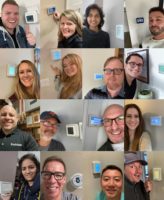
Scientific evidence is clear: human impact on our world is increasing global warming trends. Reports of our impact on the planet pour in citing mega droughts, severe wildfires and the United Nation’s “code red” status. At Resideo, we’re focused on protecting what matters most. In the simplest sense, that means your home, family or business, and in the richest Read more
Scientific evidence is clear: human impact on our world is increasing global warming trends. Reports of our impact on the planet pour in citing mega droughts, severe wildfires and the United Nation’s “code red” status.
At Resideo, we’re focused on protecting what matters most. In the simplest sense, that means your home, family or business, and in the richest sense – what matters most is our collective home: planet Earth.
We’re doing our part to help deliver a more sustainable future, and our customers are also following suit. For example, more than 40% of Resideo’s revenue** comes from sustainable solutions, meaning those solutions with the capability to contribute to energy savings in your home or building.
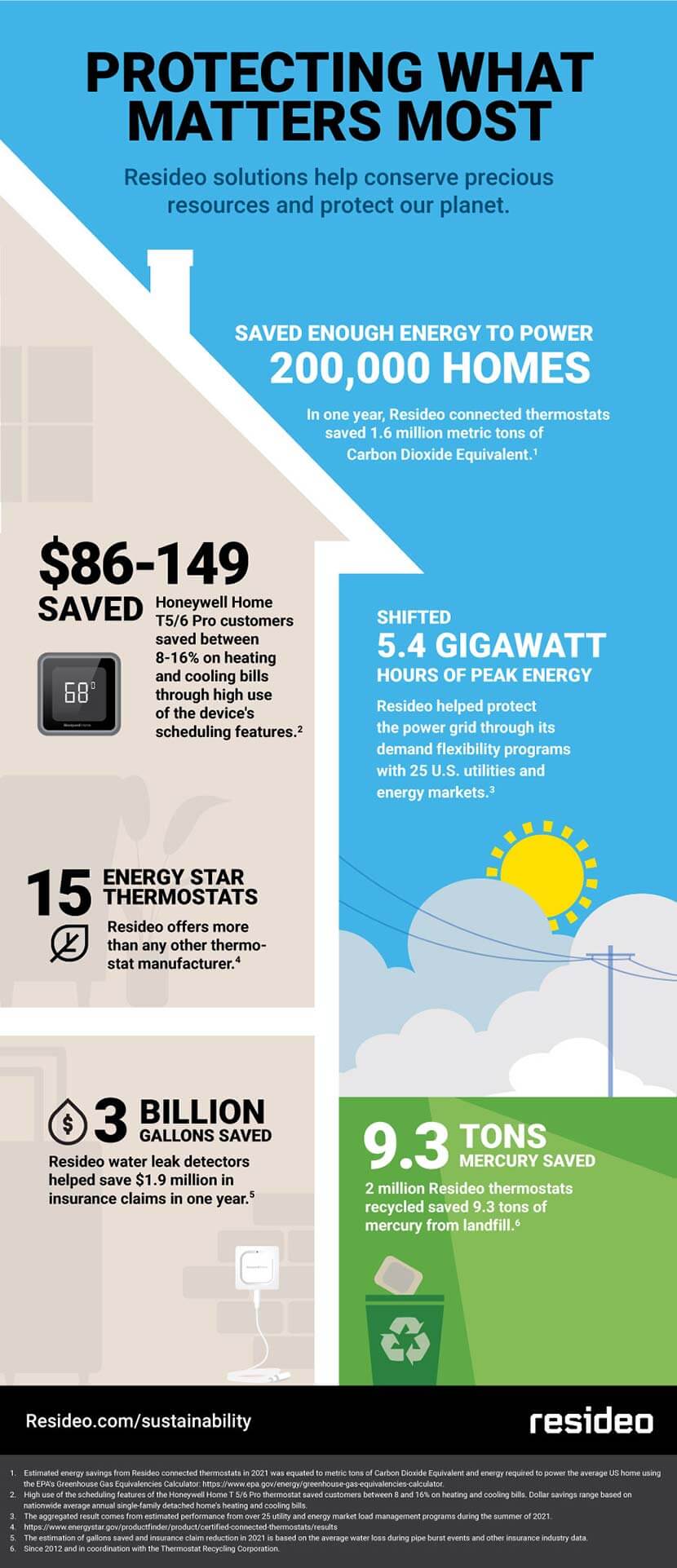 We know that sometimes the smallest things—such as a thermostat—can make the biggest impact on a home’s energy use, and even the planet. Everyday actions can add up to big change, and Resideo is committed to helping our customers be part of the solution.
We know that sometimes the smallest things—such as a thermostat—can make the biggest impact on a home’s energy use, and even the planet. Everyday actions can add up to big change, and Resideo is committed to helping our customers be part of the solution.
Each day, I’m proud to work for an organization that treats every day like Earth Day. We strive to advance comfort, safety and well-being with solutions that can benefit the planet and people living on it. Our goal is to deliver products and services that limit their impact on the environment and the people who manufacture, distribute, and use them during their life cycles.
We have a responsibility to our employees and customers to manufacture responsibly, which is why we set a goal of reducing our company’s greenhouse gas (GHG) emissions 20% by 2025, compared to the 2019 baseline. We’re well on our way with reductions in GHG emissions and energy and water consumption, and half of our sites operate on a strong environmental management system.
Once our products are in distribution, our strong community partnerships, help support the next generation of skilled trades men and women through Resideo Academy and Building Talent Foundation. Our partnership with Habitat for Humanity International allows us to deploy our solutions that can help save energy and water.
Our solutions are designed to help ensure people have a comfortable, safe and efficient home. Internally, we are bringing diverse voices to the table to unlock new sustainable innovations. In use, we are proud that our solutions help alert homeowners to more potential water leaks, help save them energy and water, and help prevent costly insurance claims.
Fifty percent of energy costs come from heating and cooling your home and 44% of U.S. Internet households say they actively work to reduce energy consumption at home. Resideo suggests several ways to create a more earth-friendly home.
- Perform a Home Energy Audit. Learn where and how you consume energy in your home and make corresponding adjustments to help save money each month. Resideo created this home energy audit checklist with additional tips.
- Upgrade to Energy Star Appliances. With more ENERGY STAR-rated products than any other thermostat manufacturer, Resideo’s Honeywell Home thermostats are energy efficient and can help save 8% of heating and cooling or $50 per year.
- Leverage Thermostat Technology. One of the biggest mistakes you can make is keeping your thermostat set at the same temperature all day, every day. Instead, you can deliver comfort when at home and energy savings when you’re away. According to the U.S. Department of Energy, you can save as much as 10% a year on heating and cooling by simply turning your thermostat back 7-10 degrees Fahrenheit from its normal setting for eight hours a day. Don’t forget to also unlock rebates from your local utility.
- Recycle Old Technology. Whether you’ve just uninstalled your previous thermostat, or you’re looking to do so in the future, we recommend safely recycling your outdated thermostat. Responsibly recycling the old is as important as upgrading to a new efficient product in terms of its impact on the environment.
For more information, visit Resideo.com/sustainability.
 Erin Woodward is based in Minnesota and served as a municipal development volunteer in the U.S., Peace Corps for two years in El Salvador, Central America. She leads sustainability for Resideo’s Products & Solutions business, where she champions bringing Environmental, Social and Governance (ESG) into the business strategy and innovation pipeline. Erin sat on the steering committee for the Sustainable Growth Coalition, a business led partnership building collaborative circular economy projects to advance clean energy and protect and restore the natural water cycle.
Erin Woodward is based in Minnesota and served as a municipal development volunteer in the U.S., Peace Corps for two years in El Salvador, Central America. She leads sustainability for Resideo’s Products & Solutions business, where she champions bringing Environmental, Social and Governance (ESG) into the business strategy and innovation pipeline. Erin sat on the steering committee for the Sustainable Growth Coalition, a business led partnership building collaborative circular economy projects to advance clean energy and protect and restore the natural water cycle.
Erin holds a Bachelor of Arts in International Relations and Spanish from Saint Anselm College in Manchester, New Hampshire and a Master of Nonprofit Administration from Hamline University in St. Paul, Minn.
**Based on Resideo sustainable offering criteria of products that have the capability to directly (primarily) contribute to energy savings.

By: Erin Woodward, Resideo Global Sustainability Leader Scientific evidence is clear: human impact on our world is increasing global warming trends. Reports of our impact on the planet pour in citing mega droughts, severe wildfires and the United Nation’s “code red” status. At Resideo, we’re focused on protecting what matters most. In the simplest sense, that means your home Read more
By: Erin Woodward, Resideo Global Sustainability Leader
Scientific evidence is clear: human impact on our world is increasing global warming trends. Reports of our impact on the planet pour in citing mega droughts, severe wildfires and the United Nation’s “code red” status.
At Resideo, we’re focused on protecting what matters most. In the simplest sense, that means your home, family or business, and in the richest sense – what matters most is our collective home: planet Earth.
We’re doing our part to help deliver a more sustainable future, and our customers are also following suit. For example, more than 40% of Resideo’s revenue** comes from sustainable solutions, meaning those solutions with the capability to contribute to energy savings in your home or building.
We know that sometimes the smallest things – such as a thermostat – can make the biggest impact on a home’s energy use, and even the planet. Everyday actions can add up to big change, and Resideo is committed to helping our customers be part of the solution.
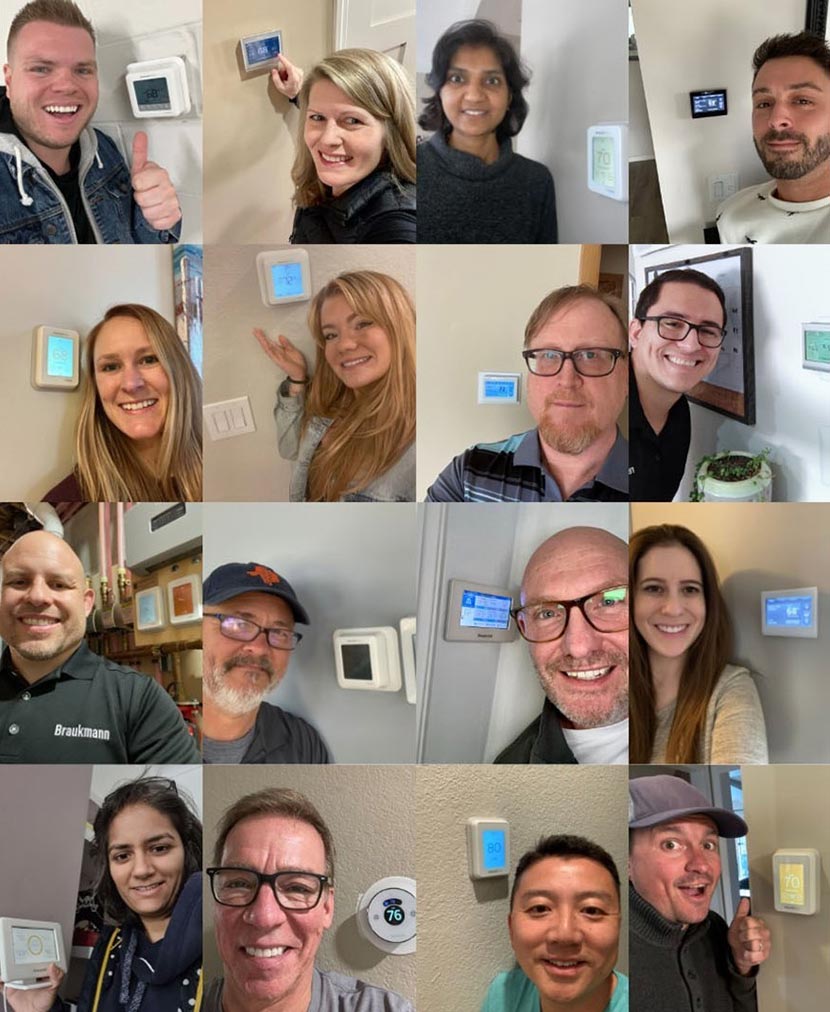
Resideo’s global employees showcase their commitment to sustainability for Earth Day 2022.
RESIDEO EARTH DAY STATS
- Fifty percent of energy costs come from heating and cooling your home and 44% of U.S. Internet households say they actively work to reduce energy consumption at home. (Parks Associates, February 2022)
- More than 40% of Resideo’s revenue** comes from sustainable solutions, meaning those solutions with the capability to contribute to energy savings in your home or building.
- With more ENERGY STAR-rated products than any other thermostat manufacturer, Resideo’s Honeywell Home thermostats are energy efficient and can help save 8% of heating and cooling or $50 per year.
- According to the U.S. Department of Energy, you can save as much as 10% a year on heating and cooling by simply turning your thermostat back 7-10 degrees Fahrenheit from its normal setting for eight hours a day.
RESIDEO’S COMMITMENT TO SUSTAINABILITY
Each day, I’m proud to work for an organization that treats every day like Earth Day. We strive to advance comfort, safety and well-being with solutions that can benefit the planet and people living on it. Our goal is to deliver products and services that limit their impact on the environment and the people who manufacture, distribute, and use them during their life cycles.
We have a responsibility to our employees and customers to manufacture responsibly, which is why we set a goal of reducing our company’s greenhouse gas (GHG) emissions 20% by 2025, compared to the 2019 baseline. We’re well on our way with reductions in GHG emissions and energy and water consumption, and half of our sites operate on a strong environmental management system.
Once our products are in distribution, our strong community partnerships, help support the next generation of skilled trades men and women through Resideo Academy and Building Talent Foundation. Our partnership with Habitat for Humanity International allows us to deploy our solutions that can help save energy and water.
Our solutions are designed to help ensure people have a comfortable, safe and efficient home. Internally, we are bringing diverse voices to the table to unlock new sustainable innovations. In use, we are proud that our solutions help alert homeowners to more potential water leaks, help save them energy and water, and help prevent costly insurance claims.
FOUR WAYS YOU CAN HELP MAKE A DIFFERENCE
Fifty percent of energy costs come from heating and cooling your home and 44% of U.S. Internet households say they actively work to reduce energy consumption at home. Resideo suggests several ways to create a more earth-friendly home.
- Perform a Home Energy Audit. Learn where and how you consume energy in your home and make corresponding adjustments to help save money each month. Resideo created this home energy audit checklist with additional tips.
- Upgrade to Energy Star Appliances. With more ENERGY STAR-rated products than any other thermostat manufacturer, Resideo’s Honeywell Home thermostats are energy efficient and can help save 8% of heating and cooling or $50 per year.
- Leverage Thermostat Technology. One of the biggest mistakes you can make is keeping your thermostat set at the same temperature all day, every day. Instead, you can deliver comfort when at home and energy savings when you’re away. According to the U.S. Department of Energy, you can save as much as 10% a year on heating and cooling by simply turning your thermostat back 7-10 degrees Fahrenheit from its normal setting for eight hours a day. Don’t forget to also unlock rebates from your local utility.
- Recycle Old Technology. Whether you’ve just uninstalled your previous thermostat, or you’re looking to do so in the future, we recommend safely recycling your outdated thermostat. Responsibly recycling the old is as important as upgrading to a new efficient product in terms of its impact on the environment.
**Based on Resideo sustainable offering criteria of products that have the capability to directly (primarily) contribute to energy savings.


